Ian Hamilton
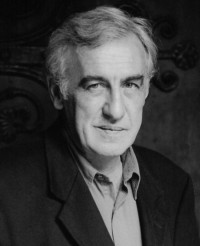
(Robert)Ian Hamilton was born on March 24th 1938, the second son of Robert Tough and Daisy (McKay) Hamilton, who had left their native Glasgow in 1936, and were then living in King’s Lynn.
In 1951, the family – now increased by the arrival of another son and daughter – moved from Norfolk to Co. Durham, settling in Darlington. Hamilton was sent to the local grammar school, and it was there, during his last year, that he launched his first literary magazine. Although it only ran to two issues, and he later made light of the thing – claiming that it consisted of little more than letters of refusal from the well-known figures he’d asked to contribute – The Scorpion demonstrated not only its seventeen-year-old editor’s precocity but also his persuasiveness, for amongst the people who didn’t refuse him were some of the period’s leading men of letters.
Hamilton took his university entrance examination in 1955 and was offered a place to read English at Keble College, Oxford. Entry had to be deferred for two years while he did National Service, but when, in 1958, he did go up to Keble, he quickly established a name for himself, at least among those who took writing seriously. Within a year of his arrival, he had launched a new literary magazine, Tomorrow. This may have started out a little uncertainly – ‘with lashings of Michael Horovitz and thin jests from the 21-year-old Roger McGough’, as John Fuller recently remarked – but by the time of its third and fourth issues, it was looking a lot more confident, and a lot more interesting. Issue no. 4 had contributions from Christopher Middleton, Thomas Blackburn, Alan Brownjohn and others. It also featured the script of an early play by Harold Pinter, the first time this had appeared in print.
"What of the next ten years? Ian Hamilton feels that little magazines have a tendency to run down and become exhausted. Though there is no sign of this yet as far as The Review is concerned, he feels that the point may be approaching and that the magazine may be ready for a change of course. His plans for the future are ambitious, though at present he is unwilling to make them public. Whatever they are, however, if The Review can maintain in its second ten years the liveliness and intelligence of its first decade then it won’t go far wrong."
Hamilton was playing his cards just a little bit closer to his chest than Boston realized, for he had already decided that the tenth anniversary issue was to be the last. Not only had the steam gone out of it, as he’d hinted, but the magazine had never achieved its hoped-for circulation figures, and was crippled by debts. In 1974, Hamilton launched his fourth literary magazine, The New Review. The ambition of this large-format glossy was evident from the start: Vol. 1, No. 1 was almost 100 pages long and contained poems, fiction, essays and reviews by Al Alvarez, Martin Amis, Caroline Blackwood, Melvyn Bragg, Russell Davies, Rosemary Dinnage, Douglas Dunn, Colin Falck, David Harsent, Francis Hope, Dan Jacobson, Clive James, Robert Lowell, Julian Mitchell, Edna O’Brien, Jonathan Raban, Lorna Sage, and George Steiner. It also featured a number of photographs, some of them by the up-and-coming Fay Godwin. Like its predecessor, The New Review made a decisive contribution to the cultural climate of the times, not least by its encouragement of younger writers. Martin Amis has already been mentioned, but others of his generation were also being given a platform, amongst them Julian Barnes, Jim Crace, James Fenton, Ian McEwan, Andrew Motion, Sean O’Brien, Tom Paulin, Craig Raine, and Christopher Reid. Even so, the magazine was not to last. It was heavily dependent on Arts Council funding, and when, four-and-a-half years after it was launched, that funding was withdrawn, The New Review promptly went out of business. Hamilton had given up his editorial positions at the TLS and The Observer some years before, and for a time earned his living on Grub Street, writing most regularly for the New Statesman, which gave him the opportunity to change direction slightly by employing him as its television reviewer. Then came something altogether unexpected: an invitation to write the biography of Robert Lowell, who had died in 1977. Hamilton took just four years to complete the task, and his 500-page book, Robert Lowell: A Biography (1982), was a huge critical success, on both sides of the Atlantic. The reviewers – and these included figures such as John Carey, Peter Davison, Richard Ellmann, Anthony Hecht, Karl Miller, Robert B. Shaw, John Simon, Richard Tillinghast and Helen Vendler – were full of praise; but so too were intimates of Lowell’s, many of whom wrote to Hamilton to express their feelings in private. Lowell’s second wife, Elizabeth Hardwick, wrote as follows: ‘Your book is very different from the ones we are accustomed to here. There is a finer intelligence in it and a greater equality than usual between the subject and the biographer. Your distance, the method, is full of Scottish virtue and sets the work apart from that feeling of a hovering heir among our academics.’ Another one to express himself like this was the novelist and short story writer, Robie Macauley, who had known Lowell since the late 1930s: ‘I am reading the Lowell with fascination and great admiration. I’ve always been confident that you would do a fine job, but this surpasses even those high expectations. You are the only man who could have done it. It needed your kind of long view and deliberation – and I can’t think of anyone who knew Cal who’d have that in just the way you have.’ After the success of the Lowell book, it was only natural that Hamilton should think of writing more biographies, if suitable subjects presented themselves. In Search of J.D. Salinger (1988) was his next, but it was a very different book, whose subject did everything in his power to thwart it, dragging Hamilton and his publishers into the law courts (and thereby guaranteeing just the sort of media attention that unhampered publication would probably have spared him). Mordecai Richler waxed indignant: ‘At the risk of sounding stuffy, I think it indecently hasty to undertake a biography-cum-critical study of a still-working writer and in highly questionable taste to pronounce him a perfect subject because, in Mr Hamilton’s view, “he was, in any real-life sense, invisible, as good as dead.”’ But Richler’s views were not widely shared, and Jonathan Raban’s assessment of the book – he called it ‘a sophisticated exploration of Salinger’s life and writing and a sustained debate about the nature of literary biography, its ethical legitimacy, its aesthetic relevance to a serious reading of the writer’s books’ – was closer to the general estimate. Hamilton’s next biographical subject was very different again. A Gift Imprisoned: The Poetic Life of Matthew Arnold (1998) explores Arnold’s reasons for abandoning his life as a poet and settling for three decades of drudgery as an educationist and social reformer. Nicholas Murray described it as an ‘absorbing’, ‘highly readable’, ‘acute’ and ‘illuminating’ study, and this will have been a particularly welcome judgement, coming as it did from someone who had published a full life of Arnold only two years earlier. Keepers of the Flame (1992), though not itself a biography, was borne out of Hamilton’s fascination with the genre. It deals with literary estates, but as the author wrote in his foreword: ‘A book about literary estates has to be about many other things as well: about changing notions of posterity, about copyright law, publishing, the rise of English Studies, the onset of literary celebritism. Principally ... it has to be about biography, the history and ethics of. How much should a biographer tell? How much should an executor suppress? And what would the biographee have wanted – do we know?’ John Sutherland began an enthusiastic review of the book with the words: ‘Hamilton could not, if he tried, write an unreadable book.’ And Jeremy Treglown declared it ‘an absorbing and drily funny book’, whose author was ‘characteristically inquisitive and detached, humorous, knowledgeable and sympathetic.’ Keepers of the Flame was Hamilton’s own favourite amongst his prose works. Since the early 1970s, the poems had been coming even more slowly, but they were still being written, and in 1988 Faber published Fifty Poems, which combined The Visit’s thirty-three with eleven of the twelve he’d included in a 1976 pamphlet called Returning, and rounded this out with just six more. The book came with a preface, which began: ‘Fifty poems in twenty-five years: not much to show for half a lifetime, you might think. And in certain moods, I would agree.’ Not so most of the book’s reviewers. Douglas Dunn’s notice was fairly representative: ‘In spite of his poems’ shortness, his absolutely countable quantity of published verse, Hamilton’s lyricism still seems to me to add up to the best love poetry by a writer of his generation.’ There were one or two dissenting voices, however. Lachlan Mackinnon lamented Hamilton’s failure to work harder at his poetry: ‘It is a great pity that shunting poetry aside has left [him] so little work to show, for he could have been a larger poet and a more skilful influence. The decision to live another kind of life may not have been easy, but it is not only Hamilton who has been impoverished by it.’ Elizabeth Jennings was somewhat harsher, writing as if she felt that ‘shunting poetry aside’ was something Hamilton ought to have considered doing earlier: ‘The overall impression is one of dissatisfaction couched in a lacklustre vocabulary ... The tone throughout is low-key and there does not seem to be much development over the longish period in which these poems were written ...’ Between 1984 and 1987, Hamilton hosted BBC TV’s Bookmark programme. Among the many distinguished writers who were featured during his tenure were J.G. Ballard, Seamus Heaney, Alison Lurie, Italo Calvino, Simon Gray, R.S. Thomas, William Trevor, Timothy Mo, A.N. Wilson, Joseph Skvorecky, Peter Reading, Kazuo Ishiguro and Peter Taylor. Two more collections of poems appeared in the 1990s, with Steps (1997) adding ten new poems to his tally, and Faber’s Sixty Poems (1998) placing these alongside the fifty they had published a decade before. One or two reviewers were disappointed by the newest poems. Ian Grigson, for example, spoke of ‘how the edgy, baffled minimalism of [Hamilton’s] earlier work has crumbled into thinness and inconsequence’. But again, the majority of reviewers reacted quite differently. Lavinia Greenlaw thought that ‘Sixty Poems is sure to be one of the most affecting and satisfying collections we will see this year,’ and Alan Brownjohn, pronouncing Hamilton ‘an original’, quoted with approval David Harsent’s claim that this was a poet with a ‘uniquely lyrical, passionate, and sorrowing voice’. Sixty Poems was a Poetry Book Society recommendation. There is all too much that cannot be covered in a note of this kind, but it would be a serious omission not to mention Hamilton’s passion for football. Not all of us could share that passion, but anyone admiring Hamilton’s prose – its rhythm, timing, suppleness and brio – will have found Gazza Agonistes (1998), the book he wrote about his sporting hero, Paul Gascoigne, hard to put down if they once picked it up. Susannah Herbert, though indifferent to the game, wrote: ‘You don’t need to know much about football to recognize that Gazza is a sporting hero with a difference – but Hamilton goes deeper, tracing the evolution of the player’s image with affection and a certain head-shaking sadness, like a mystified parent. I didn’t want to care, but I did.’ Just how good an editor and anthologist Hamilton was can be seen from the sheer quantity of this kind of work he was commissioned to do. His most significant achievement in this field was undoubtedly the Oxford Companion to 20th-Century Poetry (1994), for which he put almost two-hundred-and-fifty noted contributors to work, watching over them as they composed the best part of 2,000 entries, covering ‘topics, movements, magazines and genres as well as individual poets, dead and alive’ from 1900 all the way up to the early ‘90s. Helen Vendler was sure the Companion would come to be seen ‘as a significant landmark of literary change.’ Hamilton was an early contributor to the London Review of Books, whose founding editor, Karl Miller, he had worked for when Miller was literary editor of the New Statesman and editor of The Listener. Hamilton soon found himself on the paper’s editorial board, alongside Frank Kermode, V.S. Pritchett, Stuart Hampshire and other notables, and he served the paper loyally, under Miller to begin with, and then Mary-Kay Wilmers, for the next two decades. Many of his best essays – several of them reprinted in his collections, Walking Possession (1994) and The Trouble with Money (1998) – first appeared in the LRB’s pages. Hamilton’s last book, Against Oblivion: Some Lives of the Twentieth-Century Poets (2002), has only just been published. ‘Some time ago,’ he says in his introduction, ‘it was suggested to me that I might try to write an updated, twentieth-century version of Samuel Johnson’s Lives of the Poets. Like Johnson, I would – it was proposed – compose mini-biographies plus mini-critiques of about fifty modern poets ... All in all ... this Johnson update seemed a nice idea, if somewhat gimmicky, and I agreed to have a go.’ Thus far, no consensus seems to have emerged. John Carey was extremely positive: ‘Stylish, gritty, often hilarious, Against Oblivion glitters with insights like flecks of mica. It gives precise expression to things you have noticed but not been able to formulate ... It is the cleverest, tersest introduction to 20th-century poetry you could hope to find, written by a man who has earned the right to be uncompromising.’ Robert Potts, by contrast, was airily dismissive: ‘a piece of light entertainment, close to hack work: risk-free speculation in the poetic futures market.’ And somewhere between Carey and Potts was Anthony Thwaite, who found the book ‘crisp, sharp, opinionated, readable,’ but also thought it ‘vulnerable’, claiming to find some of its inclusions and exclusions a little eccentric. It seems only right to mention that Between The Lines owes its existence to Ian Hamilton. He sprang the idea for it on the two people who became his co-editors over lunch – one of those played-with-but-uneaten lunches for which he was famous – late in 1997. It is doubtful whether such an enterprise could have got going as quickly as it did without his flair – or, of course, his reputation. When one of us, early on, said he thought that a well-known poet we were thinking of inviting to participate would decline, a mischievous smile crossed Ian’s face: ‘He wouldn’t dare,’ he said – and events did not prove him wrong. It is a great sadness to his colleagues at BTL that Ian did not live to see this volume, and that he will not be around to work with us on others. He died from cancer on December 27th 2001, aged 63, leaving one son (Matthew) by his first wife, Gisela Dietzel, two sons (Robert and Ricki) by his second wife, Ahdaf Soueif, and a son and a daughter (William and Catherine) by his last partner, Patricia Wheatley.
– Philip Hoy, 2002
Books by Ian Hamilton
Between The Lines Imprint
-
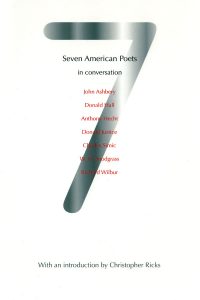
Seven American Poets in Conversation
John Ashbery et alPub: Jun. 5th, 2008 £10.99 Add to cart -
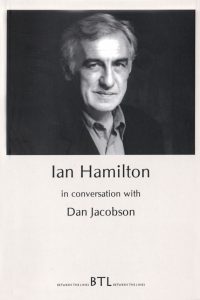
Ian Hamilton in Conversation with Dan Jacobson
Ian HamiltonPub: May. 2nd, 2002 £10.95 Add to cart -
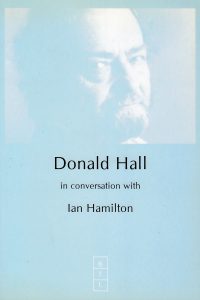
Donald Hall in Conversation with Ian Hamilton
Donald HallPub: Feb. 1st, 2002 £9.50 Add to cart -
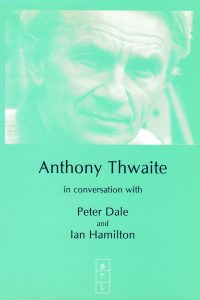
Anthony Thwaite in Conversation with Peter Dale and Ian Hamilton
Anthony ThwaitePub: Mar. 4th, 1999 £9.50 Add to cart
